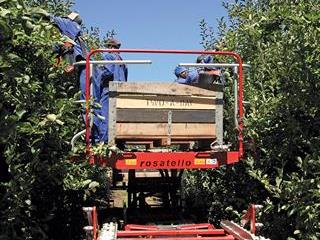
Growers at fruit company Two-a-Day constantly search for methods to improve the livelihoods of their workers. Last year, they identified picking platforms as one such method and subsequently imported these machines from Italy through the company’s subsidiary, Lazy Leopard.
The platforms offer several benefits:
- Increased efficiency
Labourers work far more speedily than when using ladders. Dr Mias Pretorius, technical manager at Two-a-Day, estimates that approximately 75% of a worker’s time is wasted on moving ladders. Trials using platforms for young tree manipulation and hand thinning in Ceres revealed a 300% increase in labour efficiency over ladder usage.
“The great benefit of improved labour efficiency is that it reduces costs and in effect frees up money that can be directed towards higher wages for labourers,” Pretorius says.
- A more diverse workforce
The platforms allow growers to employ women and older people in the orchards. These people are not strong enough to carry ladders. Employing a more varied workforce means more than one person per family can be employed, thus improving community livelihoods.
- Increased production
According to Pretorius, Two-a-Day growers have seen significant increases in production due to new orchards coming on stream. Production has increased from 225 000 bins in 2010 to over 300 000 bins in 2016. More orchards means more people are employed.
Purchasing Platforms
Last year, Pretorius, along with Two-a-Day technical adviser Daan Brink and six company growers, travelled to the US and Italy to learn about the platforms used in those countries. “The growers liked the Rosatello the best,” Brink recalls. “It seemed like an easy machine to operate, it was much more affordable than some of the more sophisticated machines. It’s manufactured by a small family business.”
The platforms cost around €30 000 (R520 000) each, depending on added extras, and Pretorius expects the capital investment to pay for itself in under two years.
Growers who purchased the platforms claim a 50% to 100% increase in labour efficiency for most tasks, such as young tree manipulation and tree pruning and thinning. Results are however, dependent on tree architecture, landscape and climatic conditions. Results for picking have not been as favourable, because most of the orchards in which the platforms are used have not yet been fully adapted to enhance mechanisation, according to Pretorius.
Two-a-Day had previously experimented with a Gossamer platform, a South African product. Although reasonably priced, the platform has to be pulled by a tractor.
“We found that platforms pulled or built around tractors are suitable for relatively fast activities, such tree manipulation. However, they aren’t suited to activities that require more attention to detail, such as picking, because the slowest gear of the tractor is too fast for these activities,” Pretorius explains. “Driving that slowly isn’t good for a tractor – over time it will result in either the clutch or gear giving in.”
The Rosatello platform has a hydraulic drive, which allows it to drive extremely slowly. It has a top speed of 10km/h and there is a choice between a diesel- or battery-operated system. Growers have thus far opted for the diesel-operated system. The platforms are hooked onto a tractor when moved between orchards.
The machines are available in widths of 1,7m to 1,9m and can be extended to between 3,4m to 3,9m. They are available in lengths of 3m to 4m and extension heights of between 1,05m and 2,95m.
There have been some growing pains with the new platforms, and Pretorius reports that the manufacturers have been more than willing to assist, by travelling to South Africa and making the necessary adjustments. For example, a negative brake and side-to-side levelling have been added to stabilise the platforms and assist with hilly conditions on South African farms. To keep the machine simple, electric buttons have been installed to manage these new functions.
Orchard Adaptations
For these platforms to work optimally, orchards have to be adjusted accordingly. According to Brink, old orchards were previously planted with an inter-row spacing of 4,5m and an intra-row spacing of 1,5m. These trees grew to a depth of up to 2m on each side, which would have made it difficult for platforms to move between. The depth of the trees also made picking difficult.
The new orchards consist of high-density trees planted on either a spindle or an adapted double palmette training system. The trees are planted at an inter-row spacing of 3m to 3,5m and an intra-row spacing of 1m to 1,5m. The depth of the trees is only about 1m on each side, allowing easy movement through the orchard as well as easy picking, since everything is at arm’s length.
Pretorius says that growers are still hesitant to move to ultra-high density plantings, such as a V system, where the tree is manipulated into two carrier branches, as they have not found suitable dwarfing rootstocks that would help to inhibit growth sufficiently.
Growers have, however, changed the way bins are used in order to save time. Previously, growers used a bin-on-a-trailer system, but now use a bin-on-the-ground system. Pretorius explains that labourers pick fruit and deposit it in a bin pulled by a tractor.
Once the bins are full, the tractor unloads them and fetches new bins. Growers have also switched to pneumatic or battery pruning shears, as workers now spend far longer pruning trees in one go, compared with when they used ladders. Pneumatic shears assist to prevent a labourer’s hands from becoming too tired due to the increased volume of work.
For more information, email Dr Mias Pretorius at [email protected].













